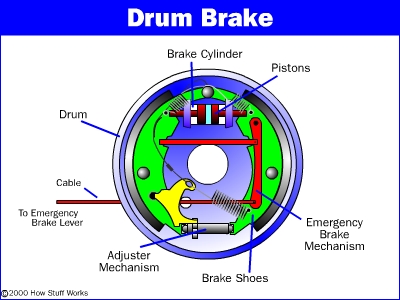Drum Brakes
Drum Brakes contain many parts as compaired to the simpler disc brake. But the drum brake also contains and emergency brake. Besides the parts listed the drum brake has many springs and a special shoe adjuster

.
Springs are needed in these brakes to pull the shoes away from the drum. In most drum brakes there is a wedging affect between the shoes. The shoes push themselves against the drum when released. This extra braking power given by the wedge affect will make it easier for them to actuate. A smaller piston can be used now because of this wedge affect.
There are more springs besides the springs used to pull the shoes from the drum. They are used to pull the adjuster arm back into position.
In drum brakes when the shoe wears down there is a problem. The piston will not be able to push the brakes out as far. There is a mechanism that will readjust the brakes so that they are farther out, closer to the drum. As you see in the diagram below, the shoes have been worn down. When you press the button, look at the top. The shoes comes off of the gray bar. This action makes the adjuster lever move up. Then shoe is brought back up by the springs. At the same time the mechanism lever comes back down and turns the little gear. This gear as splines in it so when it is turned it will expand. By expanding the arm the brakes are now closer to the drum and everything is back to normal. The piston will be able to do its job efficiently.
Emergency brakes stop a car from moving if it is parked on a hill. They lock up the rear wheels. Some racers use their emergency brakes in races to help them turn or drift.
Emergency brakes on drums are simple. There is a cord that comes from the lever inside the car. This cord pulls a lever on one of the shoes. This lever is also connected to the opposite shoe with a bar. When the lever is pulled it pushes both shoes out locking them in place. Here is a diagram of drum anti-lock brakes.
Anti-Lock Brakes
Anti-lock Brake Systems(ABS) are there to help with braking. When you brake hard you will end up locking your tires up before your car stops. When you lock those tires up you decrease stopping distance but you decrease the control you have over your car. The ABS is there to prevent your tires from locking up so that you can remain in control of your car even while braking hard.
The ABS determines your tire speed and it will regulate the brake fluid pressure so that you get the best breaking with the tires locking up.
The parts of an ABS system are: speed sensors, valves, a pump, and a main controller. They each have their own job as explained below.
The speed sensors do exactly what they sound like, they calculate the speed that your wheels are rotating at. They are located on the axels usually on the differential or near each tire depending on the setup.
The valves are located usually under the hood with the pump and controller. The valves tap into the brake lines and control where the fluid goes. If the valve is closed then the pressure going to the brake remains the same, even if you press the brake harder it will have the same pressure. The closed valve isolates you from that specific brake line. If the valve is open then the pressure is whatever it would be normally controlled by the main cylinder and pedal pressure. In the last position the valve will re-route the fluid in order to release fluid pressure.
The pump is located in the engine compartment. The pump is what will restore the pressure if you release it.
The main controller controls everything. It is a computer that monators the speeds and tells the valves when to open or close and the pump when to function. It is located with the last two parts.
When your car is running the computer will be monatoring the speed at all times. It is looking for fast deceleration. With out it your tires will lock up way before your car stops. When the ABS controller senses a fast deceleration, it will release brake pressure until the tires starts to speed up again. When the tires speeds up to however fast the car is moving it will add pressure again to decelerate the car. It will do this quickly before the tire gets to the point of lock-up. The ABS will keep doing this to make perform better braking. If you press the pedal and feel different pressures that because the ABS is working.
ABS Setups
Now before I mentioned the speed sensors, I also talked about different setups. There are a few different setups you can have that differ by the number of sensors and the number of valves.
There is a four sensor, four valve setup where there is a sensor and valve for each tire. This is the best setup because each tire will be able to brake at its full potential.
There is a Three sensor, three valve ABS setup that has two sensors in the front on each tire and one on the back axel. The front is favored because it is what retains a lot of the weight when stopping. The rear must have both tires decelerate quickly before it qill activate would could mean that one tire can lock up before the ABS kicks in.
Finally, there is a one sensor, one valve setup. This system is located on the rear wheels only. It is just like the last one in that both tires must start to lock up before it will work.
Return to Main Page